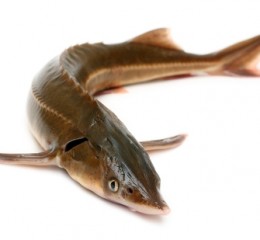


Only the eggs of the sturgeon can be called caviar. Victim of over-fishing and of their late-developing sexual maturity, these fish have largely disappeared from the wild. Farming has long been carried out. It supplies more and more of the stock, and with increased quality due to their being fished in their natural habitat. Russia and Iran have long worked at restocking the Caspian Sea: they put in several million young sturgeons every year. In biological terms, the sturgeons form the Chondrostei group. Their family can be traced back almost to the beginning of time: 350 million year old fossils attest to that. The species of the sturgeon family have stretched bodies and flattened stomachs: these are signs of their life on the sea-bed. They have a tail fin (on the back, near the tail) and some of them have a long rostrum which flattens out in the shape of a spatula at the very end.
There are 9 main sturgeon families: the Polyodontidae (in which is found the famous spatula fish from the Mississippi and China); the Eurasian Huso, which are among the largest fish in the world; the Scaphirhynchinae from the Mississippi basin; the Pseudoscaphirhynchus from the Aral Sea basin; the Acipenser, which have Adriatic, Transpacific and North Atlantic varieties; and the North American potamodrome species. You will find further information on the 'Details of Species' pages. The most expensive, sought-after caviar comes from the eggs of the Beluga and the Huso Huso (from the Eurasian Huso family – which have the largest eggs). The Acipenser family, with its light-coloured eggs (see our Beluga and Ossetra caviars) is also greatly valued.
The name 'caviar' can only be applied to the eggs from fish in those nine families. Even so, it's sometimes applied to salmon eggs... or even aubergine grains.
This family of sturgeons is represented by the Polyodon spathula and the Psephurus gladius. The former lives in the Mississippi Basin.It can live for more than 30 years, reach 3 metres in length and weigh 100kg. Its eggs are a beautiful grey-green. Previously victim of over-exploitation in Tennessee, its fishing is now strictly regulated. The Psephurus gladius lives in China's River Yangtze. It also grows to a maximum 3 metres, but can weigh up to 300kg. It's the largest Chinese freshwater fish. Even if this species iis protected, it is still in danger of extinction and the attempts at farming have not yet been successful.
It is said that in this family of sturgeons there have been fish weighing more than 1 tonne! Today, however, the largest specimens weigh less than 250kg. Among these fish we find the famous Huso Huso or Beluga whose eggs are the most sought after as caviar. It is the emblematic sturgeon of the Caspian Sea. Fishing it is now extremely tightly regulated. Its cousin the Huso Dauricus (or Kaluga) is slightly smaller, but has a much larger mouth. It mainly inhabits the River Amur but it is also found in the Sea of Japan. Every year, Russia reintroduces farmed juveniles of each of these species.
The sturgeons in this family are potamodromous. In other words they migrate, but spend all their lives in fresh water, unlike other sturgeons which are anadromous. The latter, like salmon, live in the sea and then migrate up into fresh water to spawn. The Scaphirhynchus family is divided into 3 species: Albus (the females wait 15 years before procreating), Platorynchus (Shovelnose) and the Suttkusi (also known as the Alabama sturgeon). This family of fish suffered a lot from serious water pollution to the point where its eggs cannot be eaten.
This family of sturgeons is one of the most extensively fished for their eggs. Every year, in the Sea of Azov, Russia puts back millions of farmed juveniles. However, this is insufficient to curtail the danger to this species. In this same family there are the Russian sturgeon or Ossetra (Caspian Sea, Black Sea and Sea of Azov), the Persian sturgeon (Caspian Sea and Black Sea), the Sevruga (greatly appreciated for its eggs) and the Bare-bellied sturgeon (named after its bony badges which disappear with age) whose intensive over-fishing in the Caspian Sea is worrying.
This sturgeon family is so named because it migrates without ever leaving fresh water. It includes the Acipenser ruthenus or Sterlet, the Baeri or Siberian sturgeon (found in Lake Baikal), the Adriatic and Italian sturgeon (found in the delta of the River Po) or the Amur sturgeon. This entire family is endangered, but certain species (such as the Italian) are now farmed. The Amur sturgeon is supervised by both the Chinese and Russian authorities which re-introduce young sturgeons into the river.
The most important member of this family, the European sturgeon, currently lives (although there are very few of them) in the Gironde area of France and along its coastline. It used to be found in most French rivers and coasts, even in the Mediterranean. It is farmed (especially in the Gironde area) for its caviar. The European sturgeon can carry out long migrations (more than 1,000km!) to spawn.
The Atlantic sturgeon lives on the east coast of the United States, but some have recently been identified in the Gironde area where it has apparently been living for thousands of years.
This sturgeon family comprises two species. The shortnose sturgeon (Acipenser brevirostrum) lives on the eastern coast of North America from Florida to Canada. The lake sturgeon (Acipenser fulvescens) also called 'yellow sturgeon' lives in the calm rivers and lakes of the Mississippi Delta, the Hudson River and the St Laurence River. Its eggs produce excellent caviar, and so is in increasing demand.